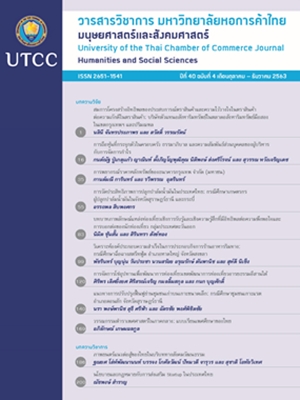Thai Action Cinema in the Socio-Cultural Context
Main Article Content
Abstract
The memory of Thai action cinema is limited to entertainment and projection of Muay Thai as the national heritage. This article aims to discuss some philosophy and socio-cultural value having been looked over via the early works comprising Ong Bak and Tom Yum Kung which passed on concepts and spiritual messages about Thainess through the image of ancient Muay Thai. In brief, each film tells the story of the character who practices Muay Thai to the degree that he becomes a supreme human being. He achieves the strength in terms of mind, body, and intelligence and will only performs Muay Thai as ruled by the ancient tradition. It is to protect the weak, the nation, including the righteousness. This reflects Thainess from the civilized perspective as well as suggesting superiority of Thai culture amidst the stream of westernization whose theme lends weight to the external development other than the internal one.
Article Details
ลิขสิทธิ์ของบทความ
ผลงานที่ได้รับการตีพิมพ์ถือเป็นลิขสิทธิ์ของมหาวิทยาลัยหอการค้าไทย ห้ามมิให้นำเนื้อหา ทัศนะ หรือข้อคิดเห็นใด ๆ ของผลงานไปทำซ้ำ ดัดแปลง หรือเผยแพร่ ไม่ว่าทั้งหมดหรือบางส่วนโดยไม่ได้รับอนุญาตเป็นลายลักษณ์อักษรจากมหาวิทยาลัยหอการค้าไทยก่อน
References
กฤตยา ณ หนองคาย. (2556). พระเอกและผู้ร้ายในภาพยนตร์แนวต่อสู้ผจญภัยของไทย: การวิเคราะห์ลักษณะการผสมผสานทางวัฒนธรรม (วิทยานิพนธ์ปริญญาดุษฎีบัณฑิต ไม่ได้ตีพิมพ์). จุฬาลงกรณ์มหาวิทยาลัย, กรุงเทพฯ.
จรัสเดช อุลิต, แสวง วิทยพิทักษ์, สนอง แสงสุข, ศรณ์ สุขพิมาย, พัฒนา บุญวงศ์, และธานี หอมจำปา. (2556). การจัดการความรู้มวยไทย 5 สาย. กรุงเทพฯ: กรมส่งเสริมวัฒนธรรม.
จัตุชัย จําปาหอม. (2550). พัฒนาการกีฬามวยไทยไชยา (วิทยานิพนธ์ปริญญามหาบัณฑิต ไม่ได้ตีพิมพ์). มหาวิทยาลัยราชภัฏหมู่บ้านจอมบึง, ราชบุรี.
"จีจ้า" เปิดตัว "ช็อคโกแลต" คว้าชัยตรุษจีน 35 ล้าน. (2551, 17 กุมภาพันธ์). ผู้จัดการออนไลน์. สืบค้นจาก https://mgronline.com/entertainment/detail/9510000019695
เจริญทอง เกียรติบ้านช่อง. (2562). มวยไทยทั้ง 5 สาย. สืบค้นเมื่อ 1 พฤษภาคม 2563, จาก https://jaroenthongmuaythaisrinakarin.com/blog/read/36
เชิญ 'จา พนม' เป็นทูตมวยไทย โชว์ตัวที่ประชุมไอโอซี. (2556, 10 พฤษภาคม). ไทยรัฐออนไลน์. สืบค้นจาก https://www.thairath.co.th/content/344058
ตั้ง จา พนม เป็นทูตมวยไทย. (2556, 10 พฤษภาคม). โพสต์ทูเดย์. สืบค้นจาก https://www.posttoday.com/sports/221440
ทรงธรรม ปานสกุณ. (ม.ป.ป.). สมุดไทยดำ ตำราชกมวย. กรุงเทพฯ: มหาวิทยาลัยศิลปากร, สำนักบริการวิชาการ.
ทรงพล นาคเอี่ยม. (2550). การเปลี่ยนแปลงของความหลากหลายในเชิงศิลปะการต่อสู้ป้องกันตัวไทย: กรณีศึกษามวยไทยสายพระยาพิชัยดาบหัก. (วิทยานิพนธ์ปริญญามหาบัณฑิต ไม่ได้ตีพิมพ์). มหาวิทยาลัยศรีนครินทรวิโรฒ, กรุงเทพฯ.
เทพ บุญตานนท์. (2556). พระบาทสมเด็จพระมงกุฎเกล้าเจ้าอยู่หัวกับการสร้างภาพลักษณ์ทางการทหาร (วิทยานิพนธ์ปริญญามหาบัณฑิต ไม่ได้ตีพิมพ์). จุฬาลงกรณ์มหาวิทยาลัย, กรุงเทพฯ.
ปรากฏการณ์ “ต้มยำกุ้ง” สร้างประวัติศาสตร์ หนังไทยเรื่องแรก ถล่ม BOX-OFFICE ฮอลลีวู้ดกระจุย 3 วันครองอันดับ 4 หนังทำเงินสูงสุดกวาดรายได้กว่า 5 ล้านเหรียญสหรัฐ. (2549, 12 กันยายน). ThaiPR.net. สืบค้นจาก https://www.ryt9.com/s/prg/69982
พรเทพ ฑีฆานนท์. (2555). การอนุรักษ์ศิลปะการต่อสู้มวยไทยด้วยเกม. เชียงใหม่:มหาวิทยาลัยเชียงใหม่.
พระธรรมปิฎก. (2542). ทศวรรษธรรมทัศน์พระธรรมปิฎก หมวดวิทยาศาสตร์และเทคโนโลยี. กรุงเทพฯ: ธรรมสภา.
พันนา ฤทธิไกร ปรมาจารย์ฮีโร่พันธุ์บู๊. (2548, 5 สิงหาคม). Positioning. สืบค้นจาก https://positioningmag.com/7737
ภาพันธ์ รักษ์ศรีทอง. (2562). มวยไทย มวยใคร. สืบค้นเมื่อ 9 กรกฎาคม 2563, จาก https://m.museumsiam.org/da-detail.php?MID=3&CID=177&CONID=2708&SCID=242
มนพ เวชคุณ. (2557, 15 สิงหาคม). มวยไทย สายท่าเสา: พระยาพิชัยดาบหัก [ไฟล์วีดิทัศน์].
สืบค้นจาก https://www.youtube.com/watch?v=ib5XGGECVzg
มวยไทย ธุรกิจที่เชื่อมโยงความต้องการสินค้าไทยและการท่องเที่ยวไทย. (2552, 17 ธันวาคม). ThaiPR.net. สืบค้นจาก https://www.ryt9.com/s/expd/766830
Masterpiece: พันนา ฤทธิไกร. (2554, 12 มีนาคม). Mix Magazine. สืบค้นจาก https://www.mixmagazine.in.th/view.php?ref=00000300
ยศพนธ์ สุกุมลนันทน์, และกิตติศักด์ ร่มเกษ. (2559). ประวัติศาสตร์มวยไทย. กรุงเทพฯ: กรมพลศึกษา.
ยุวดี นิรัตน์ตระกูล. (2556). มวยไทย keep fighting. TAT Review. สืบค้นจากhttp://www.etatjournal.com/mobile/index.php/menu-read-tat/menu-2013/menu-2013-oct-dec/139-42556-muay-thai
ศิลปะมวยไทย. (ม.ป.ป.). กรุงเทพฯ: กรมพลศึกษา, สถาบันอนุรักษ์ศิลปะมวยไทย. สำนักงานเสริมสร้างเอกลักษณ์ของชาติ. (2560). 100 ปี ธงชาติไทย ร้อยดวงใจไทยทั้งชาติ. กรุงเทพฯ: ผู้แต่ง.
สุทธิลักษณ์ อำพันวงศ์. (2537). ช้างไทย. กรุงเทพฯ: มติชน.
Ainslie, M. J., & Ancuta, K. (Eds.). (2018). Thai cinema: The complete guide (world cinema). London, England: Tauris.
Blanford, S., Grant, B. K., & Hillier, J. (2001). The film studies dictionary. London, England: Arnold.
Hayward, S. (2006). Cinema studies: The key concepts. London, England: Routledge.
Italy Kick Boxing. (2014, July 23). Muay Thai: The art of 8 limbs (part 1) [Video file]. Retrieved from https://www.youtube.com/watch?v=ze4RhOnMTzw
Lopattananont, T. (2014). Film or flick?: Bundit Rittakol's youth films as a reflection of socio-cultural transition in Thailand (Unpublished doctoral dissertation), Chulalongkorn University, Bangkok.
Mahmood, I. (2013). Influence and importance of cinema on the lifestyle of educated youth: A study on university students of Bangladesh. IOSR Journal of Humanities and Social Science (IOSR-JHSS), 17(6), 77-80.
Mbe, V. S. (2011). The role of film in society. Retrieved May 11, 2020, from https://thoughteconomics.com/the-role-of-film-in-society/
Shailo, I. (2017). Bollywood in the Hollywood era: Narratives of ultra-nationalism, terrorism and violence. CINEJ Cinema Journal, 6(2), 71-87.


